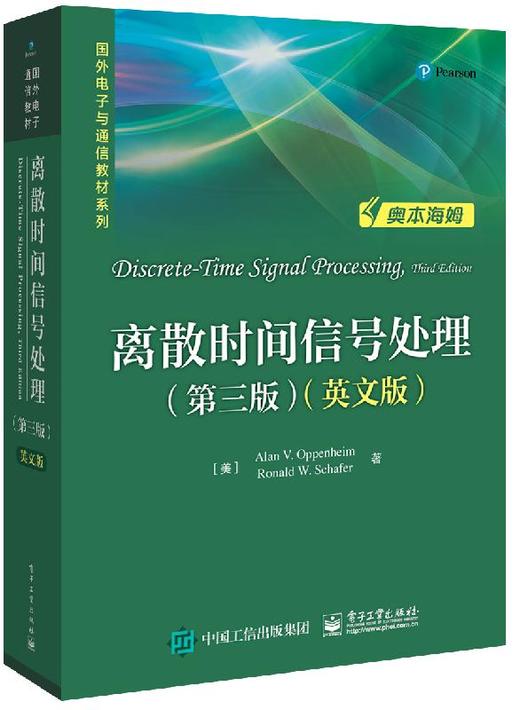商品详情
定价:199.0
ISBN:9787121372322
作者:(美)Alan,V.,Oppenheim(艾伦,?,V.,奥本海姆),,Ronald,W.,Schafer(罗纳德,?,W.,谢弗)
版次:第1版
出版时间:2019-08
内容提要:
本书系统论述了离散时间信号处理的基本理论和方法,是国际信号处理领域中的经典教材。内容包括离散时间信号与系统,z 变换,连续时间信号采样,线性时不变系统的变换分析,离散时间系统结构,滤波器设计方法,离散傅里叶变换,离散傅里叶变换的计算,利用离散傅里叶变换的信号傅里叶分析,参数信号建模,离散希尔伯特变换,倒谱分析与同态解卷积。本书例题和习题丰富,具有实用价值。本书的配套网站www.pearsonhighered.com/oppenheim提供了一些重要概念的可视化解释以及利用这些概念进行实践的操作环境,以帮助对本书内容进行增强和补充。
作者简介:
Alan V. Oppenheim MIT电气与计算机科学系Ford教授,MIT电子学研究实验室(RLE)首席研究员,美国国家工程院院士,IEEE会士,研究兴趣为通用领域的信号处理及应用,曾因出色的科研和教学工作多次获奖。其《信号与系统(第二版)》一直是行业内**的信号与系统课程教材,其“霸主”地位尚无可替代。
Alan V. Oppenheim美国麻省理工学院(MIT)电气与计算机科学系Ford教授,MIT电子学研究实验室(RLE)首席研究员,美国国家工程院院士,IEEE会士,研究兴趣为通用领域的信号处理及应用,曾因出色的科研和教学工作多次获奖。另著有 Signals and Systems, Second Edition。
目录:
CONTENTS
1 Introduction
2 Discrete-Time Signals and Systems
2.0 Introduction
2.1 Discrete-Time Signals
2.2 Discrete-Time Systems
2.2.1 Memoryless Systems
2.2.2 Linear Systems
2.2.3 Time-Invariant Systems
2.2.4 Causality
2.2.5 Stability
2.3 LTI Systems
2.4 Properties of Linear Time-Invariant Systems
2.5 Linear Constant-Coefficient Difference Equations
2.6 Frequency-Domain Representation of Discrete-Time Signals and Systems
2.6.1 Eigenfunctions for Linear Time-Invariant Systems
2.6.2 Suddenly Applied Complex Exponential Inputs
2.7 Representation of Sequences by Fourier Transforms
2.8 Symmetry Properties of the Fourier Transform
2.9 Fourier Transform Theorems
2.9.1 Linearity of the Fourier Transform
2.9.2 Time Shifting and Frequency Shifting Theorem
2.9.3 Time Reversal Theorem
2.9.4 Differentiation in Frequency Theorem
2.9.5 Parseval’s Theorem
2.9.6 The Convolution Theorem
2.9.7 The Modulation or Windowing Theorem
2.10 Discrete-Time Random Signals
2.11 Summary
Problems
3 The z-Transform
3.0 Introduction
3.1 z-Transform
3.2 Properties of the ROC for the z-Transform
3.3 The Inverse z-Transform
3.3.1 Inspection Method
3.3.2 Partial Fraction Expansion
3.3.3 Power Series Expansion
3.4 z-Transform Properties
3.4.1 Linearity
3.4.2 Time Shifting
3.4.3 Multiplication by an Exponential Sequence
3.4.4 Differentiation of X(z)
3.4.5 Conjugation of a Complex Sequence
3.4.6 Time Reversal
3.4.7 Convolution of Sequences
3.4.8 Summary of Some z-Transform Properties
3.5 z-Transforms and LTI Systems
3.6 The Unilateral z-Transform
3.7 Summary
Problems
4 Sampling of Continuous-Time Signals
4.0 Introduction
4.1 Periodic Sampling
4.2 Frequency-Domain Representation of Sampling
4.3 Reconstruction of a Bandlimited Signal from Its Samples
4.4 Discrete-Time Processing of Continuous-Time Signals
4.4.1 Discrete-Time LTI Processing of Continuous-Time Signals
4.4.2 Impulse Invariance
4.5 Continuous-Time Processing of Discrete-Time Signals
4.6 Changing the Sampling Rate Using Discrete-Time Processing
4.6.1 Sampling Rate Reduction by an Integer Factor
4.6.2 Increasing the Sampling Rate by an Integer Factor
4.6.3 Simple and Practical Interpolation Filters
4.6.4 Changing the Sampling Rate by a Noninteger Factor
4.7 Multirate Signal Processing
4.7.1 Interchange of Filtering with Compressor/Expander
4.7.2 Multistage Decimation and Interpolation
4.7.3 Polyphase Decompositions
4.7.4 Polyphase Implementation of Decimation Filters
4.7.5 Polyphase Implementation of Interpolation Filters
4.7.6 Multirate Filter Banks
4.8 Digital Processing of Analog Signals
4.8.1 Prefiltering to Avoid Aliasing
4.8.2 A/D Conversion
4.8.3 Analysis of Quantization Errors
4.8.4 D/A Conversion
4.9 Oversampling and Noise Shaping in A/D and D/A Conversion
4.9.1 Oversampled A/D Conversion with Direct Quantization
4.9.2 Oversampled A/D Conversion with Noise Shaping
4.9.3 Oversampling and Noise Shaping in D/A Conversion
4.10 Summary
Problems
5 Transform Analysis of Linear Time-Invariant Systems
5.0 Introduction
5.1 The Frequency Response of LTI Systems
5.1.1 Frequency Response Phase and Group Delay
5.1.2 Illustration of Effects of Group Delay and Attenuation
5.2 System Functions—Linear Constant-Coefficient Difference Equations
5.2.1 Stability and Causality
5.2.2 Inverse Systems
5.2.3 Impulse Response for Rational System Functions
5.3 Frequency Response for Rational System Functions
5.3.1 Frequency Response of 1st-Order Systems
5.3.2 Examples with Multiple Poles and Zeros
5.4 Relationship between Magnitude and Phase
5.5 All-Pass Systems
5.6 Minimum-Phase Systems
5.6.1 Minimum-Phase and All-Pass Decomposition
5.6.2 Frequency-Response Compensation of Non-Minimum-Phase Systems
5.6.3 Properties of Minimum-Phase Systems
5.7 Linear Systems with Generalized Linear Phase
5.7.1 Systems with Linear Phase
5.7.2 Generalized Linear Phase
5.7.3 Causal Generalized Linear-Phase Systems
5.7.4 Relation of FIR Linear-Phase Systems to Minimum-Phase Systems
5.8 Summary
Problems
6 Structures for Discrete-Time Systems
6.0 Introduction
6.1 Block Diagram Representation of Linear Constant-Coefficient Difference Equations
6.2 Signal Flow Graph Representation
6.3 Basic Structures for IIR Systems
6.3.1 Direct Forms
6.3.2 Cascade Form
6.3.3 Parallel Form
6.3.4 Feedback in IIR Systems
6.4 Transposed Forms
6.5 Basic Network Structures for FIR Systems
6.5.1 Direct Form
6.5.2 Cascade Form
6.5.3 Structures for Linear-Phase FIR Systems
6.6 Lattice Filters
6.6.1 FIR Lattice Filters
6.6.2 All-Pole Lattice Structure
6.6.3 Generalization of Lattice Systems
6.7 Overview of Finite-Precision Numerical Effects
6.7.1 Number Representations
6.7.2 Quantization in Implementing Systems
6.8 The Effects of Coefficient Quantization
6.8.1 Effects of Coefficient Quantization in IIR Systems
6.8.2 Example of Coefficient Quantization in an Elliptic Filter
6.8.3 Poles of Quantized 2nd-Order Sections
6.8.4 Effects of Coefficient Quantization in FIR Systems
6.8.5 Example of Quantization of an Optimum FIR Filter
6.8.6 Maintaining Linear Phase
6.9 Effects of Round-off Noise in Digital Filters
6.9.1 Analysis of the Direct Form IIR Structures
6.9.2 Scaling in Fixed-Point Implementations of IIR Systems
6.9.3 Example of Analysis of a Cascade IIR Structure
6.9.4 Analysis of Direct-Form FIR Systems
6.9.5 Floating-Point Realizations of Discrete-Time Systems
6.10 Zero-Input Limit Cycles in Fixed-Point Realizations of IIR Digital Filters
6.10.1 Limit Cycles Owing to Round-off and Truncation
6.10.2 Limit Cycles Owing to Overflow
6.10.3 Avoiding Limit Cycles
6.11 Summary
Problems
7 Filter Design Techniques
7.0 Introduction
7.1 Filter Specifications
7.2 Design of Discrete-Time IIR Filters from Continuous-Time Filters
7.2.1 Filter Design by Impulse Invariance
7.2.2 Bilinear Transformation
7.3 Discrete-Time Butterworth, Chebyshev and Elliptic Filters
7.3.1 Examples of IIR Filter Design
7.4 Frequency Transformations of Lowpass IIR Filters
7.5 Design of FIR Filters by Windowing
7.5.1 Properties of Commonly Used Windows
7.5.2 Incorporation of Generalized Linear Phase
7.5.3 The KaiserWindow Filter Design Method
7.6 Examples of FIR Filter Design by the KaiserWindow Method
7.6.1 Lowpass Filter
7.6.2 Highpass Filter
7.6.3 Discrete-Time Differentiators
7.7 Optimum Approximations of FIR Filters
7.7.1 Optimal Type I Lowpass Filters
7.7.2 Optimal Type II Lowpass Filters
7.7.3 The Parks–McClellan Algorithm
7.7.4 Characteristics of Optimum FIR Filters
7.8 Examples of FIR Equiripple Approximation
7.8.1 Lowpass Filter
7.8.2 Compensation for Zero-Order Hold
7.8.3 Bandpass Filter
7.9 Comments on IIR and FIR Discrete-Time Filters
7.10 Design of an Upsampling Filter
7.11 Summary
Problems
8 The Discrete Fourier Transform
8.0 Introduction
8.1 Representation of Periodic Sequences: The Discrete Fourier Series
8.2 Properties of the DFS
8.2.1 Linearity
8.2.2 Shift of a Sequence
8.2.3 Duality
8.2.4 Symmetry Properties
8.2.5 Periodic Convolution
8.2.6 Summary of Properties of the DFS Representation of Periodic Sequences
8.3 The Fourier Transform of Periodic Signals
8.4 Sampling the Fourier Transform
8.5 Fourier Representation of Finite-Duration Sequences
8.6 Properties of the DFT
8.6.1 Linearity
8.6.2 Circular Shift of a Sequence
8.6.3 Duality
8.6.4 Symmetry Properties
8.6.5 Circular Convolution
8.6.6 Summary of Properties of the DFT
8.7 Linear Convolution Using the DFT
8.7.1 Linear Convolution of Two Finite-Length Sequences
8.7.2 Circular Convolution as Linear Convolution with Aliasing
8.7.3 Implementing Linear Time-Invariant Systems Using the DFT
8.8 The Discrete Cosine Transform (DCT)
8.8.1 Definitions of the DCT
8.8.2 Definition of the DCT-1 and DCT-2
8.8.3 Relationship between the DFT and the DCT-1
8.8.4 Relationship between the DFT and the DCT-2
8.8.5 Energy Compaction Property of the DCT-2
8.8.6 Applications of the DCT
8.9 Summary
Problems
9 Computation of the Discrete Fourier Transform
9.0 Introduction
9.1 Direct Computation of the Discrete Fourier Transform
9.1.1 Direct Evaluation of the Definition of the DFT
9.1.2 The Goertzel Algorithm
9.1.3 Exploiting both Symmetry and Periodicity
9.2 Decimation-in-Time FFT Algorithms
9.2.1 Generalization and Programming the FFT
9.2.2 In-Place Computations
9.2.3 Alternative Forms
9.3 Decimation-in-Frequency FFT Algorithms
9.3.1 In-Place Computation
9.3.2 Alternative Forms
9.4 Practical Considerations
9.4.1 Indexing
9.4.2 Coefficients
9.5 More General FFT Algorithms
9.5.1 Algorithms for Composite Values of N
9.5.2 Optimized FFT Algorithms
9.6 Implementation of the DFT Using Convolution
9.6.1 Overview of the Winograd Fourier Transform Algorithm
9.6.2 The Chirp Transform Algorithm
9.7 Effects of Finite Register Length
9.8 Summary
Problems
10 Fourier Analysis of Signals Using the Discrete Fourier Transform
10.0 Introduction
10.1 Fourier Analysis of Signals Using the DFT
10.2 DFT Analysis of Sinusoidal Signals
10.2.1 The Effect of Windowing
10.2.2 Properties of the Windows
10.2.3 The Effect of Spectral Sampling
10.3 The Time-Dependent Fourier Transform
10.3.1 Invertibility of X[n,)
10.3.2 Filter Bank Interpretation of X[n,)
10.3.3 The Effect of the Window
10.3.4 Sampling in Time and Frequency
10.3.5 The Overlap–Add Method of Reconstruction
10.3.6 Signal Processing Based on the Time-Dependent Fourier Transform
10.3.7 Filter Bank Interpretation of the Time-Dependent Fourier Transform
10.4 Examples of Fourier Analysis of Nonstationary Signals
10.4.1 Time-Dependent Fourier Analysis of Speech Signals
10.4.2 Time-Dependent Fourier Analysis of Radar Signals
10.5 Fourier Analysis of Stationary Random Signals: the Periodogram
10.5.1 The Periodogram
10.5.2 Properties of the Periodogram
10.5.3 Periodogram Averaging
10.5.4 Computation of Average Periodograms Using the DFT
10.5.5 An Example of Periodogram Analysis
10.6 Spectrum Analysis of Random Signals
10.6.1 Computing Correlation and Power Spectrum Estimates Using theDFT
10.6.2 Estimating the Power Spectrum of Quantization Noise
10.6.3 Estimating the Power Spectrum of Speech
10.7 Summary
Problems
11 Parametric Signal Modeling
11.0 Introduction
11.1 All-Pole Modeling of Signals
11.1.1 Least-Squares Approximation
11.1.2 Least-Squares Inverse Model
11.1.3 Linear Prediction Formulation of All-Pole Modeling
11.2 Deterministic and Random Signal Models
11.2.1 All-Pole Modeling of Finite-Energy Deterministic Signals
11.2.2 Modeling of Random Signals
11.2.3 Minimum Mean-Squared Error
11.2.4 Autocorrelation Matching Property
11.2.5 Determination of the Gain Parameter G
11.3 Estimation of the Correlation Functions
11.3.1 The Autocorrelation Method
11.3.2 The Covariance Method
11.3.3 Comparison of Methods
11.4 Model Order
11.5 All-Pole Spectrum Analysis
11.5.1 All-Pole Analysis of Speech Signals
11.5.2 Pole Locations
11.5.3 All-Pole Modeling of Sinusoidal Signals
11.6 Solution of the Autocorrelation Normal Equations
11.6.1 The Levinson–Durbin Recursion
11.6.2 Derivation of the Levinson–Durbin Algorithm
11.7 Lattice Filters
11.7.1 Prediction Error Lattice Network
11.7.2 All-Pole Model Lattice Network
11.7.3 Direct Computation of the k-Parameters
11.8 Summary
Problems
12 Discrete Hilbert Transforms
12.0 Introduction
12.1 Real- and Imaginary-Part Sufficiency of the Fourier Transform
12.2 Sufficiency Theorems for Finite-Length Sequences
12.3 Relationships Between Magnitude and Phase
12.4 Hilbert Transform Relations for Complex Sequences
12.4.1 Design of Hilbert Transformers
12.4.2 Representation of Bandpass Signals
12.4.3 Bandpass Sampling
12.5 Summary
Problems
13 Cepstrum Analysis and Homomorphic Deconvolution
13.0 Introduction
13.1 Definition of the Cepstrum
13.2 Definition of the Complex Cepstrum
13.3 Properties of the Complex Logarithm
13.4 Alternative Expressions for the Complex Cepstrum
13.5 Properties of the Complex Cepstrum
13.5.1 Exponential Sequences
13.5.2 Minimum-Phase and Maximum-Phase Sequences
13.5.3 Relationship Between the Real Cepstrum and the Complex Cepstrum
13.6 Computation of the Complex Cepstrum
13.6.1 Phase Unwrapping
13.6.2 Computation of the Complex Cepstrum Using the Logarithmic Derivative
13.6.3 Minimum-Phase Realizations for Minimum-Phase Sequences
13.6.4 Recursive Computation of theComplexCepstrum forMinimumand Maximum-Phase Sequences
13.6.5 The Use of Exponential Weighting
13.7 Computation of the Complex Cepstrum Using Polynomial Roots
13.8 Deconvolution Using the Complex Cepstrum
13.8.1 Minimum-Phase/Allpass Homomorphic Deconvolution
13.8.2 Minimum-Phase/Maximum-Phase Homomorphic Deconvolution
13.9 The Complex Cepstrum for a Simple Multipath Model
13.9.1 Computation of the Complex Cepstrum by z-Transform Analysis
13.9.2 Computation of the Cepstrum Using the DFT
13.9.3 Homomorphic Deconvolution for the Multipath Model
13.9.4 Minimum-Phase Decomposition
13.9.5 Generalizations
13.10 Applications to Speech Processing
13.10.1 The Speech Model
13.10.2 Example of Homomorphic Deconvolution of Speech
13.10.3 Estimating the Parameters of the Speech Model
13.10.4 Applications
13.11 Summary
Problems
A Random Signals
B Continuous-Time Filters
C Answers to Selected Basic Problems
Bibliography
Index
- 电子工业出版社有限公司
- 电子工业出版社有限公司有赞官方供货商,为客户提供一流的知识产品及服务。
- 扫描二维码,访问我们的微信店铺










